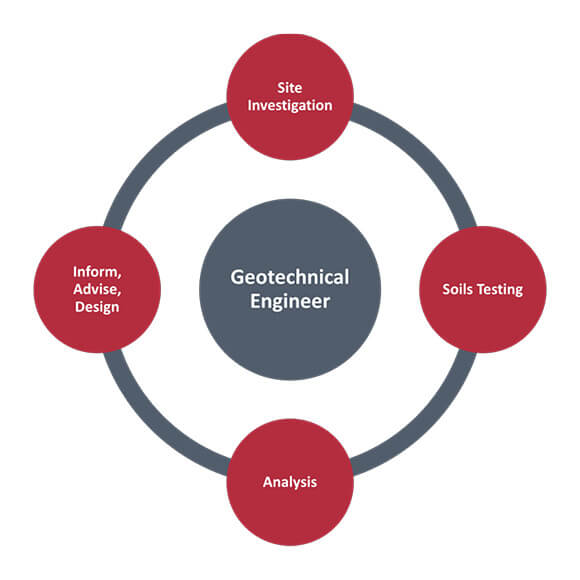Some Known Incorrect Statements About Geotheta
Some Known Incorrect Statements About Geotheta
Blog Article
The Ultimate Guide To Geotheta
Table of ContentsThe Single Strategy To Use For GeothetaSome Known Incorrect Statements About Geotheta Excitement About Geotheta4 Simple Techniques For GeothetaGeotheta for Dummies

They conduct site investigations, gather examples, carry out laboratory examinations, and evaluate data to examine the viability of the ground for construction jobs - Consulting Engineers. Based on their findings, geotechnical engineers give referrals for structure design, incline security, retaining frameworks, and mitigation of geotechnical risks. They work together with various other specialists, such as engineers, architectural designers, and building and construction groups, to make sure that geotechnical considerations are incorporated right into the overall project style and execution
By assessing the actions and properties of dirt and rock, they can recognize possible geotechnical threats such as landslides, dirt settlement, or slope instability. Their experience helps stop failures or accidents that might endanger lives and home. Here are some detailed responsibilities and duties of a geotechnical engineer: Website Investigation: Geotechnical engineers conduct website investigations to collect data on subsurface problems.
They interpret the data to understand the residential or commercial properties and habits of the soil and rock, including their strength, permeability, compaction attributes, and groundwater problems. Geotechnical Evaluation and Design: Geotechnical designers assess the data accumulated throughout site investigations to assess the security and viability of the site for building jobs. They carry out geotechnical calculations and modeling to examine elements such as birthing ability, negotiation, incline security, lateral planet pressures, and groundwater flow.
Rumored Buzz on Geotheta
Foundation Layout: Geotechnical designers play a crucial role in developing foundations that can safely sustain the intended structure. They assess the soil conditions and load demands to figure out the suitable structure type, such as shallow foundations (e.g., grounds), deep structures (e.g (https://slides.com/geotheta)., piles), or specialized methods like soil enhancement. They consider aspects such as negotiation limitations, birthing ability, and soil-structure interaction to create optimal foundation designs
They evaluate construction strategies, screen site activities, and perform area examinations to verify that the layout referrals are complied with. If unpredicted geotechnical problems arise, they assess the circumstance and provide referrals for removal or adjustments to the layout. Danger Analysis and Mitigation: Geotechnical designers assess geotechnical risks and risks related to the project website, such as landslides, liquefaction, or soil erosion.

Cooperation and Interaction: Geotechnical engineers function carefully with other specialists included in a task, such as engineers, structural engineers, and building and construction groups. Effective communication and cooperation are necessary to integrate geotechnical considerations into the general task style and building and construction process. Geotechnical designers supply technical knowledge, solution questions, and guarantee that geotechnical needs are satisfied.
3 Easy Facts About Geotheta Described
Here are some kinds of geotechnical designers: Structure Engineer: Foundation engineers concentrate on making and analyzing foundations for frameworks. They assess the dirt conditions, tons needs, and website characteristics to identify the most ideal structure kind and design, such as superficial structures, deep foundations, or specialized strategies like pile foundations.
They examine the variables affecting slope security, such as dirt buildings, groundwater problems, and incline geometry, and establish techniques to protect against incline failings and minimize dangers. Earthquake Engineer: Earthquake designers concentrate on analyzing and designing structures to endure seismic forces. They assess the seismic hazard of a site, assess soil liquefaction possibility, and create seismic style requirements to make sure the security and resilience of structures throughout quakes.
They perform area testing, gather samples, and assess the accumulated data to characterize the dirt buildings, geologic developments, and groundwater conditions at a site. Geotechnical Instrumentation Designer: Geotechnical instrumentation designers concentrate on surveillance and determining the habits of soil, rock, and frameworks. They set up and preserve instrumentation systems that keep track of factors such as dirt settlement, look here groundwater levels, incline movements, and architectural displacements to assess efficiency and provide very early warnings of potential concerns.
An Unbiased View of Geotheta
They carry out examinations such as triaxial tests, consolidation tests, straight shear tests, and leaks in the structure examinations to gather data for geotechnical evaluation and layout. Geosynthetics Engineer: Geosynthetics engineers focus on the style and application of geosynthetic products, such as geotextiles, geogrids, and geomembranes. They use these materials to boost dirt security, enhance slopes, supply drainage options, and control erosion.
They tend to be investigatory people, which indicates they're intellectual, reflective, and inquisitive. They are curious, methodical, reasonable, analytical, and rational. Some of them are likewise social, indicating they're kind, generous, cooperative, patient, caring, useful, understanding, tactful, and pleasant - Engineer of Record.
In the office environment, geotechnical designers use specialized software tools to do computations, produce designs, and examine information. They prepare reports, evaluation task specs, interact with clients and group members, and coordinate task tasks. The office setting offers a conducive setting for research study, analysis, and collaboration with various other experts involved in the task.
9 Simple Techniques For Geotheta
They frequently check out task sites to perform site examinations, evaluate geotechnical problems, and collect data for evaluation. These sees involve taking a trip to different places, occasionally in remote or challenging surfaces. Geotechnical engineers may execute dirt sampling, conduct examinations, and monitor building and construction activities to make sure that the geotechnical elements of the project are being implemented properly.
Geotechnical designers also work in specialized geotechnical labs. Geotechnical lab designers work extensively in these environments, dealing with testing devices, operating instruments, and taping information.
Report this page